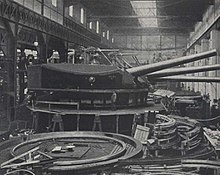Gun turret

A gun turret is a mount with one or more weapons installed on the ground, on a ship , on a plane or vehicle ( tank ) or the like . The weapons are mounted on the mount so that they can be rotated vertically to adjust the target range. The direction of travel of the vehicles serves as the appropriate target direction. In the case of floor mounting, the entire turret must be rotatable around the vertical. Tanks always have a gun turret that can be rotated through 360 °.
The weapon can be of any caliber and is used to defend the object in question or as an attack weapon. So, for example, on the German Panzer VI Tiger II (King Tiger) a turret with a 8.8-cm PAK and a 7.92-mm - MG mounted, while the bomber of the Second World War were equipped in general with machine gun towers.
Rotary towers were first designed by John Ericsson and Cowper Phipps Coles for installation on a ship deck and were later developed further. In Germany, Max Schumann and Hermann Gruson worked on further development. While the constructions proved their worth in coastal defense until the 20th century, they had to be revised for use by the land forces, for example by Schumann in 1878 with his armored car. Further successor designs then led to the design of a movable tank (Schumann and Gruson), which was a dismountable tank turret for a 12 cm howitzer, as well as a mobile tank mount (also known as Fahrpanzer for short ) for a 5.3 cm L / 25 rapid fire cannon These guns were then used in the Sereth line in Romania .
In the case of tanks with a turret, the part that is firmly connected to it and rotating with it, in which the loader, gunner and commander are located, is called the turret cage.
Gun turrets on ships
The first forms of gun turrets on warships were the armored turrets developed by Cowper Henry Coles in 1861 and by John Ericsson in 1862. They were cylindrical towers that were rotatably placed on the upper deck of tower ships and monitors . Their high weight, arranged high up in the ship, sometimes led to stability problems in the ships equipped in this way.
Towards the end of the 19th century, the modern form of the turret developed (the official designation armored turret was used by official bodies ) from three mutually movable parts:
- the barette built into the hull , an armored cylinder that rose above a circular opening on the armored deck ,
- the rotating swivel mechanism that carried the barrel cradles in which the guns lay with their trunnions ; beneath it were several circular, rotating platforms that reached below the armored deck and through which the grenades and propellant charges were transported to the guns,
- the armored rotating hood , an armored construction, which mostly had the shape of a flat, hexagonal truncated pyramid and rotated with the swivel mechanism. The most heavily armored front, the turret shield, had slit-shaped openings that pierced the barrel in which the gun barrels could move up and down when straightening.
The barbette and the other parts of the turret were not firmly connected to each other, the latter remained on the barbette solely by their own weight.
Compared to the first armored turrets, the armored Barbette moved a larger proportion of the weight down into the ship, which improved stability. In addition, an efficient, rotating ammunition supply for the guns could be installed in the Barbette. This form of the turret was common on the large warships armed with artillery ( ships of the line or battleships , cruisers ) until the middle of the 20th century.
Ships of the line and armored cruisers around 1900 carried their main armament and in some cases also the medium artillery in single or double towers. In 1909 and 1910 respectively, Italy laid the Dante Alighieri and Austria-Hungary with the Tegetthoff class, the first ships with triple towers. Triple turrets consume less weight than twin turrets for the same number of gun barrels and require less space, which made the construction of the ships easier. However, due to the difficult ammunition supply of the central cannon barrel, they had a lower rate of fire , and the proximity of the gun barrels to one another led to a greater dispersion of the projectiles at the target due to the mutual influence.
More weight and space savings, the need for which in the provisions of the Washington and London Naval Treaty were achieved with quadruple turrets (French Dunkerque- and Richelieu class , British King George V class ). However, while double or triple towers were used on almost all battleships and cruisers after the First World War, the use of quadruples was limited to the three classes of ship mentioned.
Modern warships often have guns that are provided with a closed housing and are also called turrets. However, these are unarmoured, have no barbette and the deck opening often contains a vertically rotating magazine , the summons .
Web links
Individual evidence
- ↑ Matador Model's 1/76 Gruson 5.3cm L / 24 Fahrpanzer (English) - page at Landships ; As of June 5, 2011


